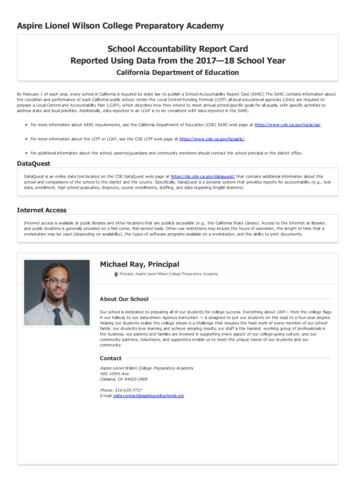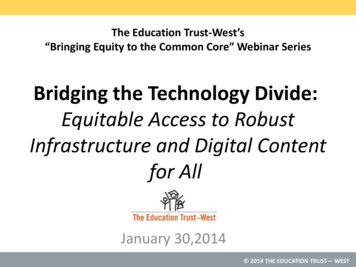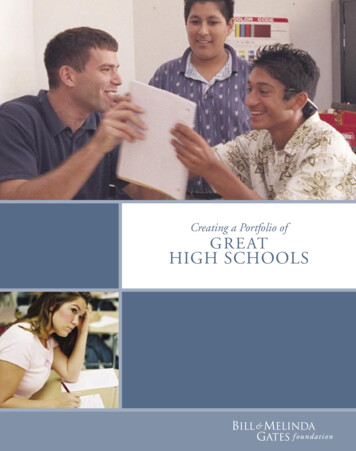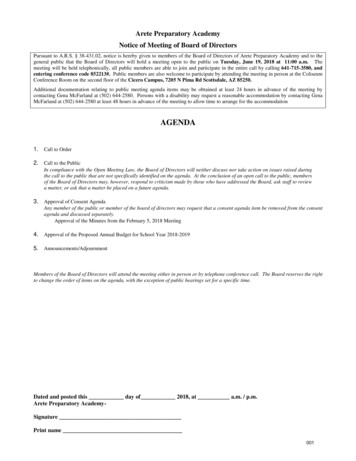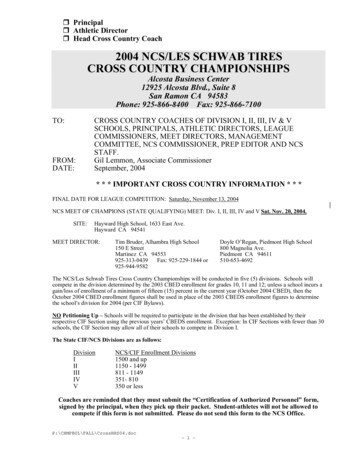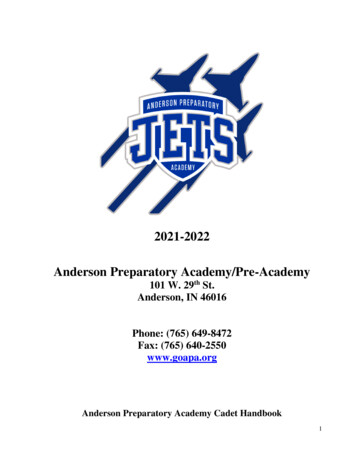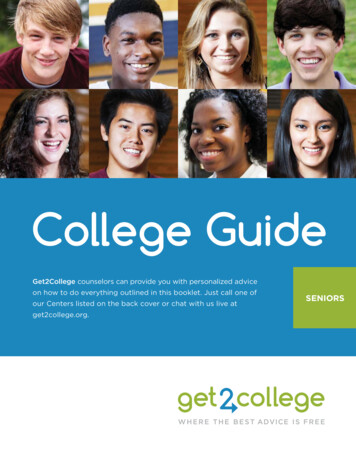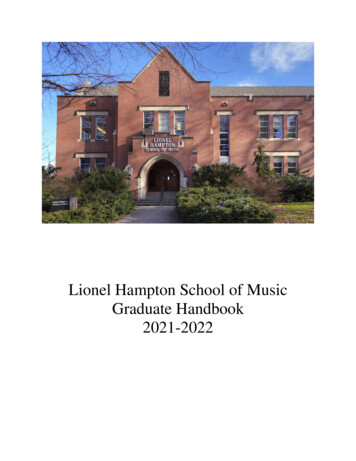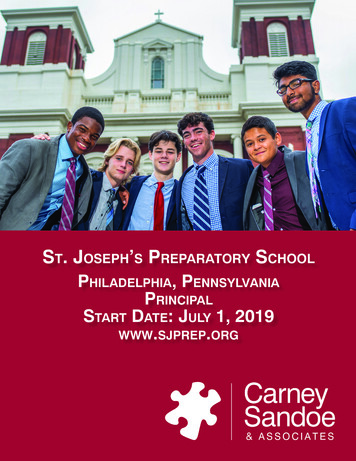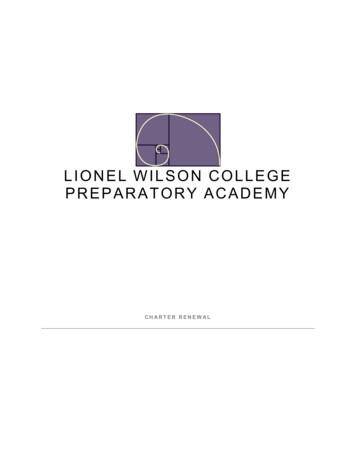
Transcription
LIONEL WILSON COLLEGEPREPARATORY ACADEMYCHARTER RENEWAL
TABLE OF CONTENTSINTRODUCTION. 3ELEMENT A: EDUCATIONAL PROGRAM . 4ELEMENT B: MEASURABLE PUPIL OUTCOMES . 14ELEMENT C: METHODS TO ASSESS PUPIL PROGRESS TOWARD MEETINGOUTCOMES . 14ELEMENT D: GOVERNANCE STRUCTURE OF SCHOOL . 16ELEMENT E: EMPLOYEE QUALIFICATIONS . 17ELEMENT F: HEALTH AND SAFETY PROCEDURES. 20ELEMENT G: MEANS TO ACHIEVE RACIAL/ETHNIC BALANCE OF DISTRICT. 20ELEMENT H: ADMISSION REQUIREMENTS . 21ELEMENT I: FINANCIAL AUDIT . 21ELEMENT J: PUPIL SUSPENSION AND EXPULSION . 22ELEMENT K: RETIREMENT SYSTEM . 23ELEMENT L: ATTENDANCE ALTERNATIVES . 23ELEMENT M: DESCRIPTION OF EMPLOYEE RIGHTS. 23ELEMENT N: DISPUTE RESOLUTION PROCEDURES. 24ELEMENT O: EXCLUSIVE PUBLIC SCHOOL EMPLOYER DECLARATION 24ELEMENT P: PROCESS FOR CHARTER SCHOOL CLOSURE . .25CHARTER-RELATED ISSUES . 27SPECIAL EDUCATION. 28DISTRICT IMPACT REPORT . 29APPENDICES . 322
INTRODUCTIONAspire Public Schools (“Aspire”) hereby respectfully submits this charter renewal onbehalf of Lionel Wilson College Preparatory Academy (“School”).School has been chartered in the Oakland Unified School District (“District”) under theauspices of Aspire since 2002. The School has had an excellent academic record includingmeeting (or exceeding) its State API growth targets. The School seeks to continue thiscontribution to the overall education opportunities available in the District.The School’s present charter is set to expire in July of 2007. The School complies withthe legal requirements for renewal as set forth in Education Code §§47605 and 47607 as it has:1.Attained (or exceeded) its Academic Performance Index (“API”) growth target inthe prior year or in two of the last three years, or in the aggregate for the priorthree years;2.Ranked in deciles 4 to 10, inclusive, on the API for a demographicallycomparable school in the prior year or in two of the last three years.(See: www.api.cde.ca.gov for further information regarding School’s academic performance)The School has done a financial analysis and projections that support continuedoperation of a 6-12 school in the District on a financially sound basis.The School is located at 400 – 105th Avenue, Oakland, California, where it has built thefacility in which operations are conducted.Aspire was founded in 1998 by experienced educators and entrepreneurs to enrichstudents’ lives and to contribute to innovation in local public school systems. Aspire currentlyoperates charter schools at 18 different campuses in various school districts throughout the Stateof California. Aspire is a California non-profit 501(c)(3) public benefit corporation and itsmission includes the following: To increase the academic performance of California’s diverse studentsTo develop effective educatorsTo share successful practices with forward-thinking educatorsIn accordance with the Charter Schools Act of 1992, Aspire hereby respectfully petitionsthe District to renew the charter for School for a five-year period, from July 2007 until July2012.The Charter Schools Act of 1992 states that:It is the intent of the Legislature to provide opportunities for teachers, parents, pupils, andcommunity members to establish and maintain schools that operate independently from theexisting school district structure, as a method to accomplish all of the following:(a) Improve pupil learning.3
(b) Increase learning opportunities for all pupils, with special emphasis on expanded learningexperiences for pupils who are identified as academically low achieving.(c) Encourage the use of different and innovative teaching methods.(d) Create new professional opportunities for teachers, including the opportunity to beresponsible for the learning program at the school site.(e) Provide parents and pupils with expanded choices in the types of educational opportunitiesthat are available within the public school system.(f) Hold the schools established under this part accountable for meeting measurable pupiloutcomes, and provide the schools with a method to change from rule-based to performancebased accountability systems.(g) Provide vigorous competition within the public school system to stimulate continualimprovements in all public schools.- California Education Code Section 47601(a)-(g)The School has made and will make important contributions to the legislative goalsoutlined above. By granting this renewal, the District will help fulfill the intent of the CharterSchools Act of 1992 (“Charter Schools Act”), while providing students in the District with asmall school option.The Charter Schools Act provides that a petition must contain reasonably comprehensivedescriptions of the elements described in California Education Code §§47605(b)(5)(A)-(P).These sections of law and the required descriptions are discussed below.ELEMENT A: EDUCATIONAL PROGRAMA description of the educational program of the school, designed, among other things, toidentify those whom the school is attempting to educate, what it means to be an “educatedperson” in the 21st century, and how learning best occurs. The goals identified in that programshall include the objective of enabling pupils to become self-motivated, competent, and lifelonglearners.- California Education Code Section 47605(b)(5)(A)Population to be Served by the SchoolThe School currently serves approximately 468 students in grades 6-12. The charter granted forSchool was a K-12 charter so that it could describe its entire K-12 educational program, while providingthe School with the possibility to expand to serve students in kindergarten through fifth grade. Thispetition for renewal is made on the same basis.According to demographic data compiled by the California Department of Education (“CDE”),the District enrolled 48,135 students in 2005-2006. Of these students, African Americans constitute39.9% of the students, American Indians 0.4%, Asians 14.8%, Filipinos 0.8%, Hispanics 35.0%, PacificIslanders 1.2% and Whites 6.0%. During the 2005-2006 school year, students who spoke English as a4
second language made up 28.4% of the student body. The School seeks to enroll a diverse population ofstudents that reflects these demographics.The School’s educational program is based on the instructional needs of our targetstudent profile. Aspire targets the following students: students who are underachieving in core academic subjects and whose performance doesnot match their potential;students whose academic needs necessitate a small school environment with personalizedattention;students whose academic needs are not being met in a traditional school environment;andstudents whose diversity represents the community.In education, one size does not fit all and Aspire is dedicated to providing students andfamilies in the District with a small school option that can help meet their needs.The 21st Century Educated PersonThe fundamental characteristic of the new millennium is ever accelerating change. Informationis multiplying as quickly as it is becoming obsolete and ideas are continually revisited, retested andrevised. At the same time, the world is becoming increasingly interdependent. These challenges meanthat students must learn to learn in order to participate in the dynamic world that is the 21st Century.The School expects its students to graduate able to collect information, think systematically andcritically about that information, create new knowledge and effectively express and apply their thinkingto real world problems. The information with which they engage may be a novel, a choreographeddance piece, a set of statistics, a newspaper report, an historical account or a scientific article. Theexpression of student thinking may come in an essay, a painting, a poem, an oral presentation, a one-actplay, a mathematical argument, or a scientific rebuttal. In summary, the School aims to graduatestudents who have the ability to access, use and analyze information, produce new knowledge andrespond critically and thoughtfully.Ultimately, the School intends to equip students with the skills they need to excel in the 21stCentury. Thus, the School will seek to enable its pupils to become self-motivated, competent and lifelong learners.How Learning Best OccursThe School’s MissionThe School’s mission is to provide all students with an exceptional education that willallow them to excel inside and outside the classroom. The School seeks to achieve this missionby offering students a rigorous core curriculum, an outstanding staff, high standards andexpectations, extended instructional hours, and personalized learning opportunities. The Schoolwill strive to ensure that students are prepared for college and for the 21st Century world andworkplace by helping them develop important basic skills, thinking skills, and life skills.The School’s Program Design Elements5
The School is structured to support high student achievement by creating as many personalizedlearning opportunities as possible. The following features, which are designed to create a sense ofcommunity, a challenging learning environment, and more time for learning, illustrate essential programdesign elements of the School and reflect Aspire’s beliefs about how learning best occurs.A Sense of CommunityAspire schools are small with small classes to create community where each student is knownpersonally. Small schoolsResearch shows that small schools allow students and teachers to develop intensive, longterm relationships that enable better conditions for teaching and learning. Aspire schoolsare designed to serve approximately 400 students. Small class sizesIn smaller classes, teachers can give each individual student the time and attentionnecessary to realize his or her personal academic goals. Aspire schools have as anobjective to maintain a 20:1 student/teacher ratio in grades K-3 and a 29:1 ratio in grades4 and above. Also, each student at the secondary level will have the opportunity toparticipate in an advisory group with a student/teacher ratio of 18:1. Advisory groupsBeginning in the 6th grade, each student is assigned to an advisory group of no more than18 students that meets regularly with an adult advisor. The advisor acts as a bridgebetween the school and the students’ other communities (e.g. family, work, clubs, socialservices agencies). The same group stays together through graduation and provides asupport structure for students.A Challenging Learning EnvironmentAspire provides students with a demanding education program and effective teachers. Rigorous and challenging education programThe School is committed to establishing high standards and expectations for all students.Multiple strategies for active learning of academic skills and mastery of a demandingcurriculum with real world connections will support all students. Highly qualified and supported teachersThe faculty will consist of well-prepared and fully certified teachers. All teachers andparaprofessionals will meet the requirements of the No Child Left Behind Act. Teacherswill be encouraged to pursue National Board Certification within their first five years atthe School. Professional development and teacher collaboration will be scheduled on aregular and on-going basis to support teachers throughout their career. In establishing aprofessional teaching environment the School will ensure collaborative planning time forteachers to design student focused curriculum, pedagogy and assessment through whichstudents can make connections, deepen their understanding of concepts and achieve athigh levels.More Time for Learning6
Aspire provides more learning time for students and uses time effectively to maximize indepth learning. Longer school dayStudents learn more when they are given more time to learn each day. With more time,teachers can create more effective projects to build higher order thinking skills. Aspireschools are designed to serve students in kindergarten through five-hour school days andstudents in grades 1-12 through seven-and-a-half hour school days. As a result, studentsat the School will receive about one more hour of instruction each day than students intraditional public schools. Longer school yearThe School will be open for 190 days of instruction, ten days more than traditional publicschools. Some of these additional days are on Saturdays. TutorsAll students will be assessed and those with literacy needs will be supported by a tutoringprogram. These tutors will be trained by an Aspire Home Office employee and havethorough background checks. Each teacher will share Aspire and classroom assessmentdata with the tutor in order to meet the student’s needs.Pedagogical StrategiesAspire recognizes that there is no single pedagogical strategy that is best for all students.Therefore, the School will employ a range of pedagogies based on “Best Practices” in the fieldand the most current educational research. The following variety of instructional methods willprovide the best opportunities for all students to learn at high levels and will be used at theelementary and/or secondary level: Direct instruction and inquiry-based instruction: Teachers will teach through both directinstruction and inquiry-based instruction. Direct instruction strategies include lectures,explanations and demonstrations through which students are asked to acquire concepts,instructions and information, learn to take notes, ask questions and clarify ideas in awhole class, small group or one-on-one format. Inquiry based instruction strategiesinvolve asking students to structure problems, pursue information, pose and testhypotheses and draw inferences for themselves. Project-based instruction: Projects create opportunities to apply learning to complexproblems as well as to develop products that require written and oral expression,extended research, analysis and synthesis of information, planning, perseverance, andorganization – all skills that are needed for success in college and the world beyond.Projects will also link the curriculum content with students’ real world experiences,making learning relevant and valuable to their lives outside of school. Research onauthentic instruction indicates the importance of connections between classroomcurriculum and the world beyond the classroom to rate and depth of learning and studentmotivation. Many of the School’s projects will be community-oriented (for example,academic projects that draw upon and contribute to the community as well as servicelearning).7
Integrated curriculum: To facilitate deep learning and connections across subjects (e.g.,history and literature) teachers will collaborate to integrate themes and concepts indesigning classes. Culturally appropriate curriculum and instruction: A multicultural curriculum andculturally sensitive pedagogy will enable students to appreciate and respect their own andeach others’ heritages and to develop an understanding of multiple perspectives. Flexible supports: Many supports will be provided within the classroom, the school andcommunity. For example, pedagogical support might include literacy support, tutoringacross subject areas, and second language learning supports. Diagnostic assessment: Teachers will use a wide range of diagnostic assessments toevaluate how students are learning as well as what they are learning. These assessmentswill inform decisions about the curriculum and teaching strategies as well as individualsupports for students. Integrated arts: Visual and performing arts are woven throughout the curriculum as away to illuminate knowledge in the core subjects. The School will bring thecommunity’s cultural resources into the classroom. Integrated technology: Technology will be used as a tool throughout students’ courses toprovide them access to information and multiple methods of expressing theirunderstanding. Authentic experiences: In the early elementary grades at Aspire schools, students learnliteracy skills through authentic reading and writing experiences, including sharedreading, guided reading, independent reading, shared writing, interactive writing, writingworkshops and independent writing. In the older elementary grades at Aspire schools,students focus on “reading to learn,” through reciprocal teaching, literature circles, andthe use of both non-fiction books and classical literature. Students also learn by applyingthe scientific method to hands-on experiments and by interacting with others oncommunity issues.Personalized Learning PlansIn order to ensure that every student is benefiting from the pedagogical practices theSchool will work with Personalized Learning Plans (PLP). The PLP will provide the teacher,parents and child with a common understanding of the student’s learning style and objectives; allparties may then act based on that understanding. Once each semester the teacher, parent andstudent will discuss the student’s learning strengths and weaknesses and set goals for the nextsemester.Supporting All StudentsBy working closely with each student and family to develop an appropriate PLP, theSchool will be able to respond to the needs of every individual student, including those who areachieving above or below expected levels. Indeed, the PLP will allow the School to help meetthe needs of students with disabilities (who will also have Individualized Education Programs(“IEPs”), as required by law), English learners, students achieving substantially above or belowgrade level expectation, and other special student populations.8
Support for English Language LearnersAspire’s English Language Learners will receive extensive support and instruction.Aspire will comply with all federal, state, and judicial mandates for English Learners. Studentswill be assessed on an annual basis by the California English Language Development Test(“CELDT”). Teachers will be trained by Aspire on administration of the CELDT andreclassification of students.English Language Learners will be immersed in English with additionalteaching strategies included in its core program, including: building on students’ culture,language and experience; teaching the second language through content; practicing Englishcooperative problem-solving groups; allowing community language norms in informal learningsituations; and using computers and peer tutors to enhance language. All students will haveaccess to the core content. English Language Development (“ELD”) and Specially DesignedAcademic Instruction in English (“SDAIE”) support will be offered both in academic classes andin supplemental settings for students who need additional support for academic content andEnglish language learning.Aspire will seek to hire faculty who have received Cross-Cultural Language AcquisitionDesign (“CLAD”) training. In addition, staff will receive training in personalizing theinstruction of English Language Learners through SDAIE, Guided Language Acquisition Design(“GLAD”) and sheltered English techniques. Ongoing coaching by our literacy and mathcoaches will also address the needs of English Language Learners.Families of English Language Learners will be supported in a variety of ways. ThreeSaturday Schools will focus on supporting students in their learning. All materials, parentconferences and presentations will be translated into appropriate languages. Parents andguardians will also be notified of student classifications of their student’s language acquisition.Support for Special Education StudentsAspire supports all special education students in compliance with state and Federal laws.No student will be denied admission to the School because he or she is in need of specialeducation services. Aspire is dedicated to working with the District to provide needed servicesto special education students as detailed in their IEP. Aspire will comply with the Federalmandate of the “least restrictive environment”, meaning the school will make every attempt toeducate special education students along with their non-disabled peers.Aspire’s education program will include instructional strategies and systems which willsupport students with special education needs. The PLP will allow the teacher, student andparent to share information and create a program which meets the student’s personal needs. Itmay include teacher interventions for a student or a list of student outcomes. The language artsand math programs focus on differentiating instruction for students. The professionaldevelopment of all teachers focuses on making the curriculum fit the needs of every child in theclassroom.Support for Under-performing StudentsThe School will have high expectations for all students and is committed to working withstudents who are not meeting outcomes to help them achieve at expected levels. Students who9
perform below the school-determined acceptable level will be able to participate in afterschooltutoring. In addition, the key elements of our education program (small schools, small classsizes, longer school day and year, Advisory groups, etc.) are designed to meet the needs ofunder-performing students.All student achievement data will be disaggregated by English Language Learners,ethnicity, socioeconomic level and gender by Aspire’s Home Office, the school, the grade leveland the classroom teacher. Powerschool will hold all critical student achievement information.Students not making adequate yearly progress on internal Aspire assessments and the STAR willbe referred for tutoring, a Student Success Team, reading intervention or any other appropriatesafety net.CurriculumThe curriculum at the School will both develop a foundation of basic skills and cultivatehigher-order thinking skills; it will be simultaneously rigorous and relevant to students. TheSchool’s educational program emphasizes interdisciplinary thinking among subject areas.Elementary CurriculumAt the elementary level, the School implements effective curriculum packages created byother parties, complementary to the Aspire system, aligned to the California state standards,while remaining research-based and complying with the No Child Left Behind Act. Language Arts: To help students develop strong literacy skills, the School uses acomprehensive language arts curriculum based on meeting students’ personal reading andwriting needs through individual and small group instruction. The School will use theOpen Court Reading Materials which are based on California state standards.The writing instruction is based on the Six Traits of Writing from the North WestRegional Laboratory: ideas, organization, voice, word choice, sentence fluency, andconventions. Special attention will be given to building a strong literacy foundation forall students early in the primary grades. The progress of ELL students will bespecifically monitored to ensure that they are making good progress in their literacydevelopment, as well as any other students who are working below grade level standards.The Aspire Language Arts Instructional Guidelines give teachers the necessary guidancefor implementing the program. Mathematics: The math curriculum is based on the California state standards formathematics. Currently, the School uses the Harcourt Brace mathematics program. Thiscurriculum sets expectations high, uses real life problems to create learning opportunities,and uses information technology extensively. The Mathematics Instructional Guidelinesgive teachers the necessary guidance for implementing the program. Science: The science program integrates science and social studies in thematic units. Theunits emphasize investigation using the scientific method (generating hypotheses anddesigning experiments to test the hypotheses), and focus on application of the scientificmethod to everyday life. The content is aligned with the California State Framework.10
Social Studies: The social studies content at the School, integrated into thematic unitswith language arts, is designed to help students make sense of their everyday life in themidst of complex social, economic and political forces. The curriculum helps studentsbecome historically literate (including culture, geography, politics, economics, andethics) and active, informed citizens (including U.S. policy and effective researchtechniques). Visual and Performing Arts: Appreciation and participation in the arts are essential toeach student’s development. To inspire students, to help ideas come to life by usingmultiple intelligences, and to ensure cultural literacy, the arts are integrated into thethematic units of each class. Life Skills: To be successful in the real world, students need to be able to work effectivelytogether, listen to each other, make good decisions and lead respectfully. Aspireincorporates these “life skills” throughout the curriculum. Teachers will both modelgood behavior and explicitly guide students in learning how to cooperate and collaborate. Other subjects: Health instruction is primarily addressed through science units. Physicaleducation and music are integrated into the units with the assistance of additionalteachers.Secondary Curriculum and Graduation RequirementsAt the secondary level, the School implements effective curriculum packages created byother parties, complementary to the Aspire system, aligned to the California state standards,while also remaining research-based and complying with the No Child Left Behind Act.Graduation Requirements Complete course curriculum requirements (See below).Pass portfolio and exhibition reviews (See below).Secondary Course Curriculum RequirementsStudents may fulfill course requirements through coursework at the School or throughapproved on-line coursework or approved coursework at a local college or community college.All students in grades 9-12 will have the opportunity and be encouraged to earn credits thatfulfill the University of California/California State University (UC/CSU) system A-Grequirements. If students choose to fulfill the UC/CSU system requirements they will earn thefollowing credits:A. Social ScienceB. Language ArtsC. MathematicsD. Lab ScienceE. Non-English LanguageF. College Preparatory ElectivesG. Visual and Performing Arts3 years4 years3 years2 years2 years2 years1 year11
Students who opt not to fulfill the UC/CSU requirements will have the opportunity tofulfill the California State Requirements for High School Graduation and will earn the followingcredits:A. Social ScienceB. Language ArtsC. MathematicsD. ScienceE. Non-English LanguageF. College Preparatory ElectivesG. Visual and Performing Arts3 years3 years2 years2 years1 year or Visual and Performing Arts2 years1 year or Non-English LanguageCurriculum and Expectations for LearningAll curriculum and expectations are informed by the California state content andperformance standards.Social Science: Curriculum in the social sciences is framed by the “History Alive/TCI” series.This series is aligned with the California state content and performance standards and is rich withslides, recordings, primary documents and more. Other text supports will include: “History ofU.S.” by Joy Hakeem, “What is Evidence” by Chris Hinton, “Eyewitness to History” by JohnCarey, a series on social justice issues from the “Facing History Facing Ourselves,” and a serieson conflicts around the world from the Cambridge University Press.Students will be expected to apply historical, political, philosophical, geographical, economicand sociological knowledge to local and global situations in order to comprehend contexts andevents, predict and evaluate the outcomes of human actions, and act responsibly as worldcitizens. Students will be expected to learn to apply chronological, thematic and integrativethinking, develop and test hypotheses about cause and effect, gather evidence to supportconclusions, use methods of historiography, conduct in-depth and relevant research, criticallyexamine sources, and synthesize ideas.Language Arts: Curriculum in the language arts is framed by “Reading for Understanding”(based on the simple premise that once students learn to read, they must then read to learn andthat there are specific skills required in reading to learn) and “Six Traits of Writing” from theNorth West Regional Laboratory (see earlier description in elementary curriculum). Texts drawfrom the great books, both classics and contemporary, and are intentionally multicultural in theirspan. Readings may include works by Sandra Cisneros, Richard Wright, James Baldwin, IsabelAllende, Julia Alvarez, Jamaica Kincaid, Toni Morrison, Chinua Achebe, Nadine Gordimer,Willa Cather, William Shakespeare, Ernest Hemingway, and Richard Rodriguez.Students will be expected to communicate ideas clearly and effec
behalf of Lionel Wilson College Preparatory Academy ("School"). School has been chartered in the Oakland Unified School District ("District") under the auspices of Aspire since 2002. The School has had an excellent academic record including meeting (or exceeding) its State API growth targets. The School seeks to continue this
